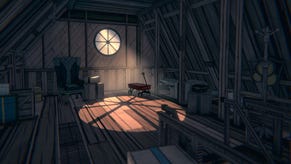The Sunday Papers
Read more
Sundays are for sitting among the detritus of you're half-packed life, trying not to go crazy while you wait for this interminable house move to be over with. Let's distract ourselves with some of the week's best games writing, shall we?
This week, Waypoint ran a series of articles exploring the ways in which prisons and games intersect, collectively named At Play In The Carceral State. There is a lot of great stuff at that link, including five articles reporting from Guantanamo Bay. Austin Walker kicked the week off with a piece explaining why they decided to explore the subject.
Why not something simpler? Why not "Prison Week" or "Games and Prisons: A Series"? Well, besides the fact that these simpler phrases feel almost light-hearted, the truth is that we're not only interested in prisons. Instead, we're interested in the wider American culture of discipline which includes surveillance, private security, prisons, and the larger criminal justice system. This is the "carceral state," a living array of infrastructure, institution, and policy that transforms the world into one of rules, borders, and confinement.
I particularly enjoyed this short documentary on how prisoners play Dungeons & Dragons, and the role it plays in their lives.
This is old - it's from 2003 - but I enjoyed reading this Gamasutra article by programmer Tom Leonard on the AI he created for Thief: The Dark Project. It talks about simulating the senses of sight and hearing, using both Thief and Half-Life as examples.
Thief: The Dark Project and its successors present a lightly scripted game world where the central game mechanic, stealth, challenges the traditional form of the first-person 3D game. The Thief player moves slowly, avoids conflict, is penalized for killing people, and is entirely mortal. The gameplay centers on the ebb and flow AI sensory knowledge of the player as they move through the game space. The player is expected to move through areas populated with stationary, pacing, and patrolling AIs without being detected, creeping among shadows and careful not to make alerting sounds. Though the game AI's senses are built on the same core concepts as those of Half-Life, the mechanics of skulking, evading, and surprising require a more sophisticated sensory system.
This is also old, but only from March of 2017. Josh Parnell is the developer of Limit Theory, a Kickstarted space game that was updating regularly a couple of years ago but then went quiet. Parnell has since been open about the risks of burnout and to mental health in indie passion projects, and talked to Oliver Milne about that at GamesIndustry.biz. Development has continued even during periods of silence and there was a development update on the game's site back in May.
"I was living alone in a cabin in the mountains of Tennessee, which is very peaceful, and that's why I wanted to develop there - but, you know, it's also a good place to go crazy, because you're alone all the time, just coding," he told us. Developing solo - despite the impressive sum raised by the Kickstarter campaign, the only parts of the project he has outsourced are the music and sound effects - Parnell was isolated when the wheels began to fall off the bus.
Inkle Studios' Jon Ingold and 80 Days writer Meg Jayanth appeared at the British Library for a conversation about adapting Verne's novel as interactive fiction. That conversation was recorded and the audio is interesting listening, charting the beginnings of the project and some of the key creative decisions they needed to make along the way.
The most recent event for us was Off the Page; a day of talks on [interactive fiction]. As part of that, Meg Jayanth and I sat down to chat about our experiences writing the game. The conversation wheels around, from mechanical camels to hidden secrets, to diversity and avoiding misplaced nostalgia - much as the game does.
Kat Brewster wrote a brief history of speedrunning, which despite the name is a comparatively in-depth look at 'how Doom and Zelda became stages for an exhilarating internet subculture'. It's easy to take long-time phenomena like speedrunning for granted.
That small number of women contributing to the Doom Usenet included Chris Norman, who ‘went by Chris at the time … to see if people would treat her differently on the net.’ In 1994, it was Norman who began the ‘first organised attempt’ of collecting the most impressive demos on what she called the LMP Hall of Fame. With a curated leaderboard to encourage them, players quickly began contributing their demos for Norman’s consideration, and an entirely online fan-built community of organised competitive play was born.
Peter "Durante" Thoman made a name for himself by fixing up console-to-PC ports post-release with unofficial patches, improving framerates and adding graphics options the developers had not. He's now doing similar work in an official capacity, and working with XSEED currently on the port of The Legend of Heroes: Trails of Cold Steel, a PS3 JRPG. He's also blogging about the work, so far in two parts: the first on performance gains and the second on graphical enhancements. I'm no tech head or framerate fetishist but this is interesting stuff.
The only true solution to the performance issue would be to completely replace the rendering backend. The underlying engine already had a DX11 backend, but unlike OpenGL/Cg it was clearly not used by Falcom during the development of Trails of Cold Steel, and the game and its assets used a very large array of features not available or not functioning in the same way in in the DX11 backend. As such, switching to the different renderer was actually a larger change in some ways than all of the PC porting work that had been done up to this point.
At Eurogamer, Robert Purchese tells the story of Horia Dociu and his father Daniel Dociu, from how the family fled Romania in the '80s, came to America, and eventually both became art directors on videogames such as the Guild Wars series. For more on the topic, check our interview with Horia from back in April.
"I was about seven years old and so it was all really vivid," Horia Dociu tells me over the phone. "They packed up fishing poles and made like they were going on vacation in Greece - it took seven years to get a visa to do even that. Then they stayed there and said, 'Hey, political asylum!' They left us with our grandparents for a year. It tore my parents up inside.
Also at Eurogamer, Christian Donlan visited Microsoft to mess around with the new MS Paint, which includes tools for making 3D models. You can tell this is premium Donlan from the first paragraph.
You should see the elevators at Microsoft's big London office. No buttons in them. Not a one. I raced in, bound for the fifth floor, and realised after an awkward pause that this elevator was only going to the second floor. An elevator that only goes to the second door? It turned out that it was only going to the second floor because the person who called it was only going to the second floor. He was stood over by the window wondering what I was up to. Welcome to the future, where you can crash someone's elevator party.
Music this week is Get Up by The Blow, who I'd never heard of til this past week.









